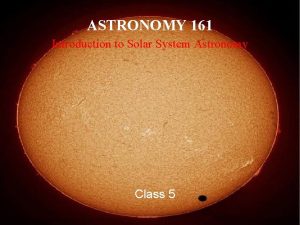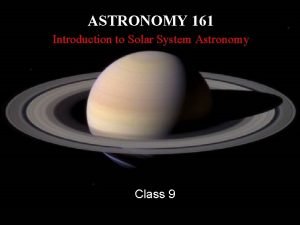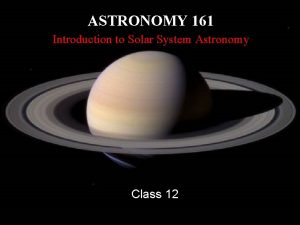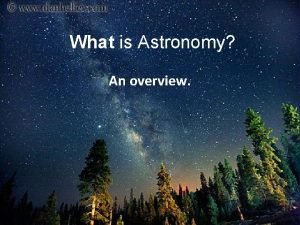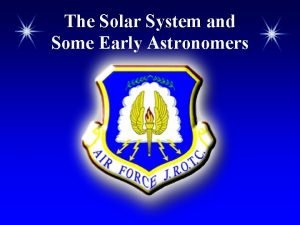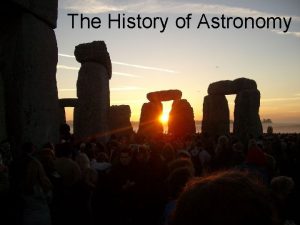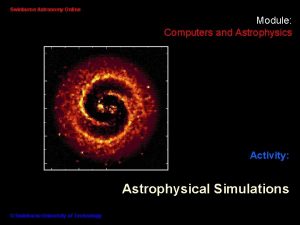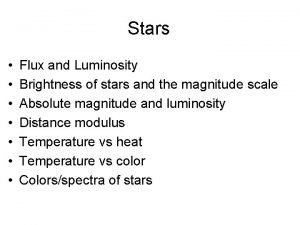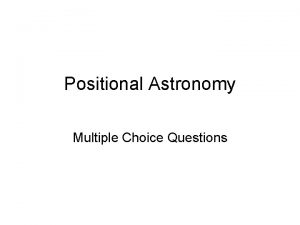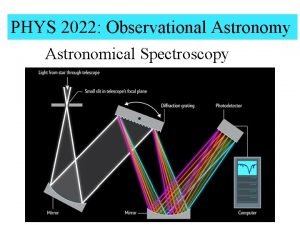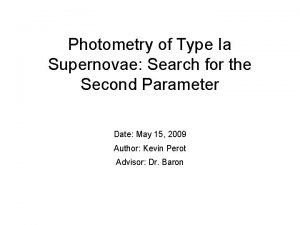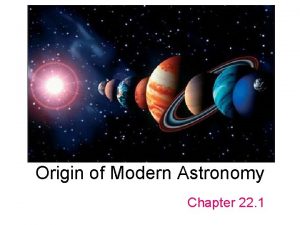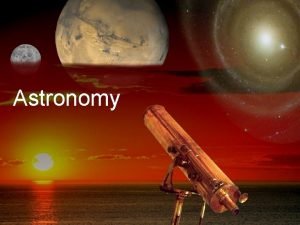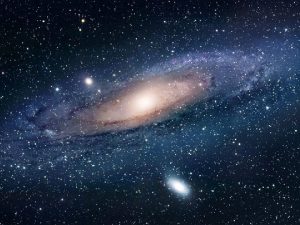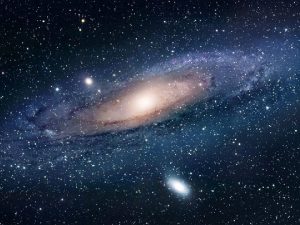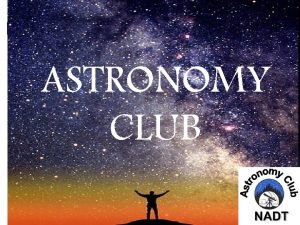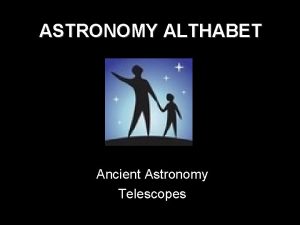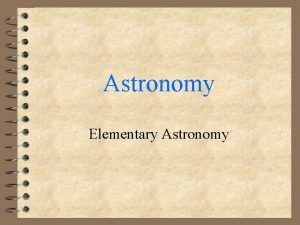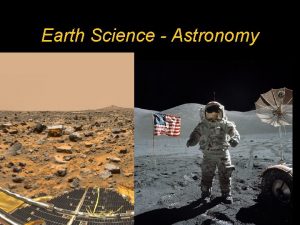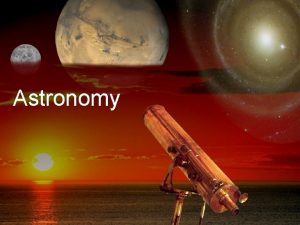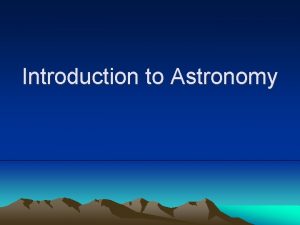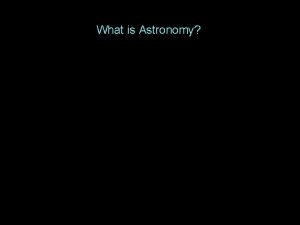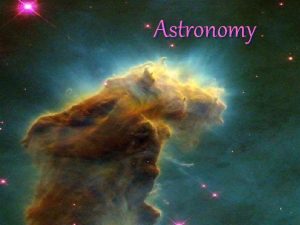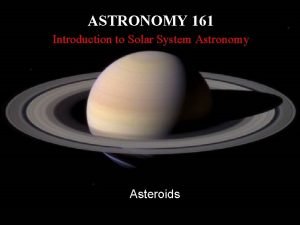The Solar System The Solar System Early Astronomy



















- Slides: 19

The Solar System

The Solar System � Early Astronomy � Astronomy- the science that studies the universe • It Investigates: properties of objects in space, and the laws under which they function. � Geocentric Model • Earth was a motionless sphere around which the rest of the universe revolved

The Solar System Ptolemy � In A. D. 141, presented an advanced geocentric model of the universe that we now call the Ptolemaic System. � The precision with which it predicted the motions of the planets, allowed it to go unchallenged for almost 13 centuries › Epicycle- small circle each planet moved on › Deferent- larger circle that the epicycle is centered on and moves around Earth

The Solar System � The Catholic Church controlled scientific thought (if they controlled scientific thought, they had more power) during this time period anyone not believing in a geocentric model of the universe was punished › Biblical passages suggest the Sun is in constant motion while the Earth remains in one place › It was thought that the creation of the planets occurred after the creation of Earth � The development of modern astronomy was a break from previous philosophy and religious views. � Scientists began to realize that the universe, and everything in it, was governed by natural laws.

The Solar System Heliocentric Model (sun at center) 1543 here comes Copernicus **actually Copernicus was not the first to suggest the heliocentric model but further developed and it eventually gained popularity � Copernicus believed the sun was at the center of the solar system and was able to work out the arrangement of the known planets

The Solar System Johannes Kepler (late 1500’s) � The path of each planet around the sun is an ellipse– oval shape › When he used circular orbits his calculations did not fit observations › More on this after Galileo

The Solar System Galileo � 1610 builds a telescope, discovers: › Moons around Jupiter �Proved not everything in the sky revolves around the Earth › Venus goes through series of phases similar to the moon’s �Not possible if both it and the Sun circled the Earth

The Solar System Now back to Johannes Kepler and ellipse… The path of each planet around the sun is an ellipse (ovalshape) with the sun at one focus and an imaginary point at the other � Eccentricity- a measure of how round or flat (oval) a shape is � Eccentricity = Distance between foci **has no units Length of the major axis �

The Solar System

The Solar System Why is eccentricity important? � All planets revolve around the Sun (one foci) along an elliptical path called an orbit › For all planets in our solar system, one of the two foci is always the sun � Planets revolve around the sun at varying speeds. › The closer the planet to the sun, the fast the speed

The Solar System � Perihelion - the point in the orbit of a planet, at which it is closest to the sun › Planets at perihelion travel faster here due to the greater gravitational attraction between the objects � Aphelion – the point in the orbit of a planet at which it is farthest from the sun › Planets at aphelion travel slower here due to less gravitational attraction WHY IS THIS TRUE?

The Solar System

The Solar System (SS)—Basic info � Scientists think the SS formed about 4. 6 billion years ago from a cloud of hydrogen, helium, rock ice and other materials pulled together by gravity � Part of the milky way galaxy (galaxy = billions of starts held together by gravity) which is a spiral galaxy � Consists of the sun, the planets, their moons, and a variety of smaller objects � Sun is at the center � Gravity holds the solar system together Distances in the SS Astronomical Unit (AU)- equal to the average distance between the sun and Earth � About 150, 000 km (93, 205 miles) � SS extends more than 100, 000 AU from the sun The Sun � 99. 85% of the mass of the solar system is contained within the sun � Mid sized star-half way though its life cycle The Planets � An object that orbits a star, is large enough to have become rounded due to its own gravity, and has cleared the area of its orbit Mercury, Venus, Earth, Mars, Jupiter, Saturn, Uranus, Neptune, **Pluto Dwarf Planets � An object that orbits the sun and is spherical but has not cleared the area of its orbit › Pluto was considered the 9 th planet of solar system but shares the area of its orbit with other objects so is now considered a dwarf planet. S Satellites � An object that orbits a planet, moons, except Mercury and Venus, every planet in the SS has at least natural satellite or moon Smaller Object � Asteroids - small rock bodies that orbit the sun � Comets- loose spheres of ice and rock that have very long narrow orbit

The Solar System In case you didn’t know….

The Solar System Terrestrial (Inner) Planets � Small � Dense � Rocky surface In order from closest – farthest from sun › Mercury �Smallest �Closest to sun �Virtually no atmosphere › Venus �Thick atmosphere, always cloudy, greenhouse effect �Hottest surface of any planet �Unusual pattern of rotation, 8 months to rotate once and 7. 5 months to revolve once � Rotates from East to West

The Solar System › Earth �The water planet- Liquid water covers about 70% of surface �Suitable temperature range for most living things to survive �Atmosphere rich in O 2, N, CO 2, greenhouse effect �One moon › Mars �The red planet �Too cold for liquid water now, had liquid water in the past �Has water ice now �Atmosphere is 95% CO 2 �Two moons

The Solar System ***Between mars and Jupiter there is an asteroid belt Gas or Jovian (Outer) Planets � Called “gas giants” � Large � Less Dense � Do not have solid surfaces � Strong gravitational force which keeps gas from escaping › Thick atmospheres � Much of the material that makes up these planets is liquid because the pressure inside these planets is so high � Have many moons � Surrounded by rings- thin disk of small particles of ice and rock

The Solar System � In order from closest – farthest from sun › Jupiter �Largest and most massive planet �Thick atmosphere of hydrogen and helium �At least 63 moons › Saturn � 2 nd largest planet in SS �Thick atmosphere of hydrogen and helium �Rings made up of chunks of ice and rock each traveling in its own orbit around Saturn �At least 61

The Solar System › Uranus �Very cold �Methane in atmosphere (give it blue color) �Surrounded by thin flat rings �Axis of rotation is about 90 o to vertical, rotates from top to bottom instead of from side to side �At least 27 moons › Neptune �Cold, blue planet �Atmosphere contains clouds �At least 13 moons › Pluto– dwarf planet �Does not clear the neighborhood of its orbit �Highly elliptical orbit � Perihelion distance = 4440 million km from sun � Aphelion distance = 7380 million km from sun
 Learning astronomy by doing astronomy
Learning astronomy by doing astronomy Learning astronomy by doing astronomy activity 1 answers
Learning astronomy by doing astronomy activity 1 answers Learning astronomy by doing astronomy activity 1 answers
Learning astronomy by doing astronomy activity 1 answers Solar system astronomy class
Solar system astronomy class Solar system astronomy class
Solar system astronomy class Solar system astronomy class
Solar system astronomy class Early cpr and early defibrillation can: *
Early cpr and early defibrillation can: * Wholesale solar module
Wholesale solar module Solar energy is free. solar is inexhaustible
Solar energy is free. solar is inexhaustible What is astronomy
What is astronomy Claudius ptolemy astronomy contributions
Claudius ptolemy astronomy contributions Astronomy greek roots
Astronomy greek roots Swinburne astronomy online
Swinburne astronomy online Mizar luminosity
Mizar luminosity Luminosity flux relation
Luminosity flux relation Vireo clea
Vireo clea Astronomy questions and answers multiple choice
Astronomy questions and answers multiple choice Phys 2022
Phys 2022 Distance ladder astronomy
Distance ladder astronomy Chapter 22 origin of modern astronomy answer key
Chapter 22 origin of modern astronomy answer key



